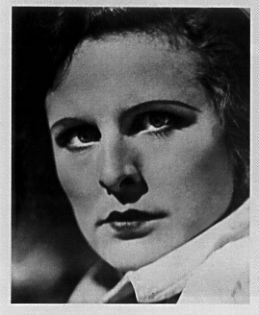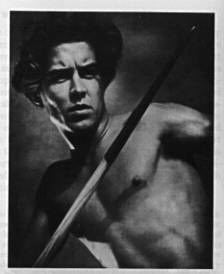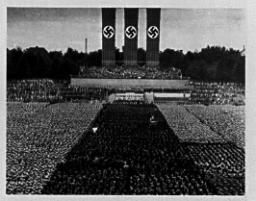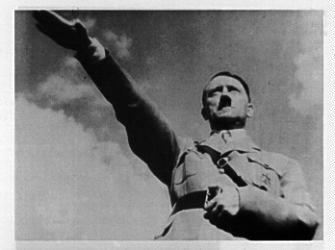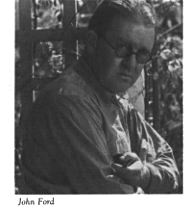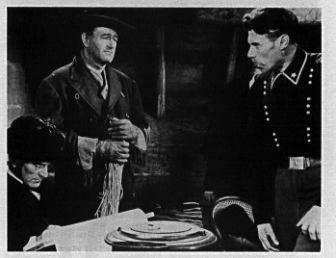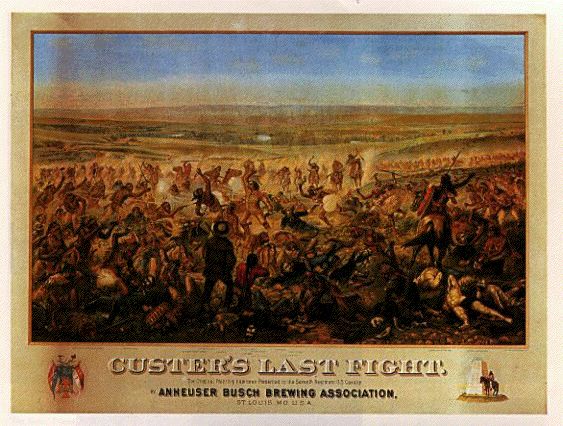
"Reel History": Film and the Study of History
A semester length Honours level subject given 1997-2000
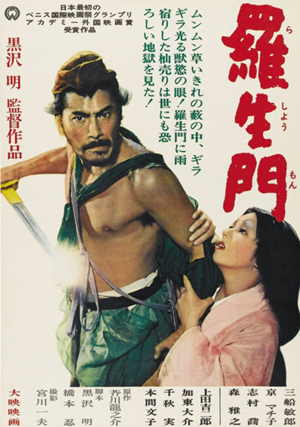 |
 |
 |
|
| An illustration from the short story "Rashomon" |
This is part of a collection of material on film and history.
Table of Contents
- Subject Outline
- Assessment
- Some of the Films we have shown in the past
- The Seminar Reading Guide
- "Reel History" - An Introduction to the Study of Film and History
- The Relative and Partial Nature of Truth and Memory - the "Rashomon Effect"
- "Restaging the Past" on Film: Peter Watkins and "Documentary Reconstruction"
- Propaganda Films as "Mirrors of Contemporary Society" - Leni Riefenstahl and Nazi Propaganda Films
- The Historian as Advisor to Filmmakers - Natalie Zemon Davis
- "Hollywood History" - John Ford and the Myth of the West
- The Filmmaker as Participant and Historian - Pierre Schoendoerffer and the French Indochinese War
- Depicting the Undepictable: The Holocaust on Film
- Documentaries and History
- A Selection of Past Exam Questions
Subject Outline
The aim of the Seminar is to examine in a critical fashion the following ("film" here means both feature films and documentaries):
- the representation and interpretation of history IN films (in other words, films as works of historical interpretation)
- films AS important historical documents in their own right (i.e. films as primary sources)
- to compare and contrast "Hollywood History" with historical films made by European and independent filmmakers
- to compare and contrast all forms of "filmed history" with the history found in traditional, printed texts
Each week we will view a feature film or documentary and discuss it in detail the following week. We will begin with a showing of Kurosawa's Rashomon (1950) which raises the problem of the relative, subjective, partial, and multi-faceted nature of truth and memory. The other films and readings have been chosen in order to illustrate a number of themes and problems in the often difficult relationship between film and history. I have selected a number of my favourite feature films and documentaries to show you - in other weeks, we will vote on what we will show (suggestions on what to see are welcome).
The seminar topics are:
- "Reel History" - An Introduction to the Study of Film and History
- The Relative and Partial Nature of Truth and Memory - the "Rashomon Effect"
- "Restaging the Past" on Film: Peter Watkins and "Documentary Reconstruction"
- Propaganda Films as "Mirrors of Contemporary Society" - Leni Riefenstahl and Nazi Propaganda Films
- The Historian as Advisor to Filmmakers - Natalie Zemon Davis
- "Hollywood History" - John Ford and the Myth of the West
- The Filmmaker as Participant and Historian - Pierre Schoendoerffer and the French Indochinese War
- Depicting the Undepictable: The Holocaust on Film
- Documentaries and History
The structure of the subject is:
- a weekly seminar - Fridays 12.30-2.00 pm Napier 304
- a weekly film - Fridays in Napier LG29 starting at 2.10 PM (and finishing whenever)
- 2 oral seminar presentations - one on a documentary and one on a feature film
- a short paper on the historiography and theory of film and history - 2,000 words worth 1/3
- a research essay on a film or a director - 4,000 words worth 2/3
Assessment
The Historiography/Theory Paper
A package of photocopied articles and chapters from books on the historiography and theory of film and history will be distributed to members of the seminar at the start of the semester. In the light of these (and other readings listed in the Seminar Reading Guide) discuss Robert Rosenstone's remark (or what I have termed "Rosenstone's Law") that the process of transferring words on the page of a history book (or ideas about the past in the mind of the filmmaker) into flickering images on a screen changes "history" into something else, with reference to one or more films and/or filmmakers we will examine during the semester:
No matter how serious or honest the filmmakers, and no matter how deeply committed they are to rendering the subject faithfully, the history that finally appears on the screen can never fully satisfy the historian as historian (although it may satisfy the historian as filmgoer). Inevitably, something happens on the way from the page to the screen that changes the meaning of the past as it is understood by those of us who work in words." (Robert A. Rosenstone, "History in Images/History in Words: Reflections on the Possibility of Really Putting History into Film," American Historical Review, December 1988, vol. 93, no. 5, pp. 1173-85. Quote on p. 1173.)
The Historiography/Theory Paper should be no more than 2,000 words in length and is due at the Seminar in Week 6 when it will be presented and discussed.
The Research Essay on Film and History
The Research Essay can be on any film or director of your choice (after consultation with me and preferrably on one or more of the films shown in the subject). The Research Essay should be between 4,000-5,000 words in length and is due at the Seminar in Week 12 when it will be presented and discussed.
There are two approaches you can take in formulating your topic. The first is to treat the film as a work of narrative or interpretative history (i.e. as a secondary source of history). The task is then to evaluate the film as a work of history:
- how historically accurate is it (in comparison with what you know from other, printed sources)?
- what kind of history is depicted in the film?
- what written or other form of history was used as a source by the director (or screenwriter) in making the film?
The second approach you can take is to use the film as a "primary source", as a document which reveals something about the time and place in which it was created. Some issues to consider include:
- when, why, and by whom was the film made?
- what does the film tell us about the time and place in which it was made?
- how did audiences react to the film when it was shown?
- if it is a propaganda film, what makes it propoganda and how successful was it as a propaganda film?
Some of the Films we have shown in the past
Westerns:
- Sam Peckinpah, The Wild Bunch (1969) (Director's cut) 2hrs 25 (WS/DVD) on demythologising the Western
- John Ford, Fort Apache (1948) 2hrs 7 - See the handouts on the other 2 films in Ford's "cavalry trilogy" - "She Wore a Yellow Ribbon" (1949) and "Rio Grande" (1950)
History and "Documentary Reconstruction":
- Peter Watkins, Culloden (1969) 1hr 12 and extract from Paul Murton, Rebellion: Culloden (1996) 50mins
Documentaries:
- Ken Burns, "The Civil War" 1863. Simply Murder. Fredericksberg and Chancellorville" 60 mins
- The World at War. Episode 17 "Morning - June-August 1944" (Thames Television 1973) (51 mins) - on the Normandy Invasion; Genocide" 50 mins and "Memory of the Camps" (1946)
- Bruce Belsham, Frontier: Stories from Australia's Forgotten War (1996). Part 1: "... They must alsways consider us as enemies, 1770-1835" (56 mins)
- Walter Cronkite's The Vietnam War: "The World of Charlie Company" (CBS, 1985) 50 mins
- The Archives Project/Rafferty, The Atomic Cafe (1982) 1hr 25 (LD)
- Claude Lanzmann, Shoah (1985) - an episode
Feature Films:
- Akira Kurosawa, Rashomon (1951) 1hr 23 (LD)
- The Historian as Advisor (Natalie Zemon Davis): Daniel Vigne, The Return of Martin Guerre (1982) 2hrs 3 (LD/WS)
- Bruce Beresford, Breaker Morant (1980) 1hr 47
Film and Nazi Propaganda:
- Leni Riefenstahl, Triumph of the Will (1935) 1hr 49
- Leni Riefenstahl's Olympia (1936)
The "Disneyfication of History":
- Pocahontas (1995)
- Hercules (1999)
The Filmmaker as Participant and Historian:
- Pierre Schoendoerffer, The 317th Platoon (1965) 1hr 24 (LD) and extracts of his documentary on the Americans in Vietnam The Anderson Platoon (1966) 1 hr
- Sam Fuller, The Steel Helmet (1951) or The Big Red One (1980)
The Holocaust on Film
- Andrzej Wajda, Korczak (1990) 1hr 50
- Steven Spielberg, Schindler's List (1993) 3 hrs 15 (LD/WS)
- Elem Klimov, Come and See (1985) 2hrs 20
- Claude Lanzmann, Shoah (1985) - an episode
The Spielbergian View of the Past
- Steven Spielberg, Schindler's List (1993) 3 hrs 15 (LD/WS)
- Amistad (1997)
- Saving Private Ryan (1999)
Historical Biography on Film :
- Abel Gance's Napoleon (1927)
- Elia Kazan's Viva Zapata (1952)
- Margarethe von Trotta's Rosa Luxemberg (1986)
- Luc Besson's The Messenger: The Story of Joan of Arc (1999)
a really bad history film for some laughs?
- Hunt's 1776 (1972) - a musical about the signing of the Declaration of Independence with Tom Jefferson high kicking?
The Seminar Reading Guide
1. "Reel History" - Introduction to the Study of Film and History
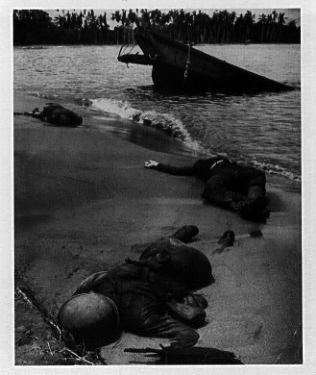 |
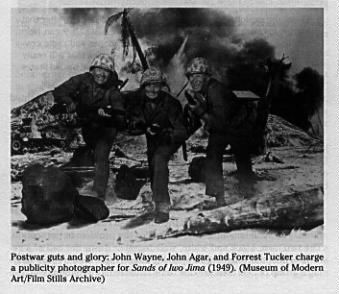 |
| Life Magazine's first published image of dead Americans | Hollywood's preferred image of combat -"Guts 'n' Glory" in The Sands of Iwo Jima |
INTRODUCTION: ROSENSTONE AND THE KEY PROBLEM OF HISTORICAL FILMS
The American historian Robert Rosenstone has observed that:
No matter how serious or honest the filmmakers, and no matter how deeply committed they are to rendering the subject faithfully, the history that finally appears on the screen can never fully satisfy the historian as historian (although it may satisfy the historian as filmgoer). Inevitably, something happens on the way from the page to the screen that changes the meaning of the past as it is understood by those of us who work in words. (Robert A. Rosenstone, "History in Images/History in Words: Reflections on the Possibility of Really Putting History into Film," American Historical Review, December 1988, vol. 93, no. 5, pp. 1173-85. Quote on p. 1173.)
Discuss Rosenstone's claim that the process of transferring words on the page of a history book (or memoir or historical novel) to flickering images on a screen changes "history" into "something else". Keep in mind the following questions:
- What is the process by which a memoir, novel, historical account, etc. gets made into a film?
- What demands must a filmmaker satisfy in making a film and how is this done (consider the roles of the studio, financial backer, the viewing public, screenplay writer, critics, actors, producers, director's personal vision)?
- What steps can a filmmaker take to ensure the "historical accuracy" of a film?
- Discuss the role of a professional academic historian as "historical advisor" to a filmmaker (e.g. Rosenstone on "Reds", Zeman Davis with "The Return of Martin Guerre", Bill Gammage with "Gallipoli")
- What is the difference between history as words on a page and history as flickering image on a screen?
ROBERT ON FILM AND HISTORY
Robert A. Rosenstone, Visions of the Past: The Challenge of Film to Our Idea of History (Cambridge, Mass.: Harvard University Press, 1996). A collection of his essays including:
- Chap. 1 "History in Images/History in Words: Reflections on the Possibility of Really Putting History into Film," pp. 19-44.
- Chap 2. "The Historical Film: Looking at the past in a Postliterate Age," pp. 45-79.
- Chap 9 "Film and the Beginnings of Postmodern History" pp. 198-225.
Robert A. Rosenstone, "History in Images/History in Words: Reflections on the Possibility of Really Putting History into Film," American Historical Review, December 1988, vol. 93, no. 5, pp. 1173-85. The lead article in a Forum on Film and History - see also the articles by David Herlihy, Hayden White, John E. O'Connor, Robert Brent Toplin.
Revisioning History: Film and the Construction of a New Past, ed. Robert A. Rosenstone (Princeton University Press, 1995). Especially Rosenstone's "Introduction", pp. 3-13.
GENERAL WORKS ON FILM AND HISTORY
Robert Brent Toplin, History by Hollywood: The Use and Abuse of the American Past (Urbana: University of Illinois Press, 1996).
Perspectives. American Historical Review Newsletter. Reel History: A Speical Issue, April 1999, vol. 37, no.4.
Any of the film reviews in the October issue of the American Historical Review since 1988. The "free choice" film at the end of the semester could be one of the films reviewed in the pages of this journal.
Mark C. Carnes, "Beyond Words: Reviewing Moving Pictures," Perspectives, May/June 1996, vol. 34, no. 5, pp. 1, 4-6.
"A Conversation between Eric Foner and John Sayles," Past Imperfect: History according to the Movies, ed. Mark C. Carnes (New York: Henry Holt, 1995), pp.11-28.
Marc Ferro, Cinema and History, trans. Naomi Greene (Detroit: Wayne State University Press, 1988).
- "Introduction: Film as Source and Agent in History", pp. 14-20
- Chap 16: "Does a Filmic Writing of History Exist?", pp. 158-165.
The Historian and Film, ed. Paul Smith (Cambridge University Press, 1976).
Leger Grindon, Shadows of the Past: Studies in the Historical Feature Film (Philadelphia: Temple University Press, 1994).
Feature Films as History, ed. K.R.M. Short (London, 1981).
Pierre Sorlin, The Film in History: Restaging the Past (Totowa, New Jersey: Barnes and Noble, 1980), "How to Look at an Historical Film," pp. 3-37.
Cinema Histories, Cinema Practices, ed. Patricia Mellencamp and Philip Rosen (University Publications of America, American Film Institute Monograph Series 4, 1984).
Steven Crofts, "Not a Window on the Past: How Film and Television Construct History," Film and History, 1987, 17 (4), pp. 90-95.
Rudy Koshar, "Siegfried Kracauer: The Historian as Photographer," American Historical Review, 1995, 100 (3), pp. 869-71.
"Historians and the Movies: The State of the Art", Journal of Contemporary History, July 1983, vol. 18, no. 3. Essays by
- Marc Ferro, "Film as Agent, Product and Source of History," pp. 357-63.
- Nicholas Pronay, "The 'Moving Picture' and Historical Research", pp. 365-95.
- Wolfgang Ernst, "DIStory: Cinema and Historical Discourse," pp. 397-409.
- R.C. Raak, "Historiography as Cinematography: A Prolegomenon to Film Work for Historians," pp. 411-38.
On the history of ideas in film - Michael T. Isenberg, War on Film: The American Cinema and World War I, 1914-1941 (London: Associated University Presses, 1981). "Part I Charting Terra Incognita: Remarks on Film and History" pp. 25-54.
SOME CASE STUDIES
Maria Wyke, Projecting the Past: Ancient Rome, Cinema, and History (New York: Routledge, 1997).
Derek Elley, The Epic Film: Myth and History (London: Routledge, 1984).
Anton Kaes, From "Hitler" to "Heimat": The Return of History as Film (Cambridge, Mass.: Harvard University Press, 1992). Especially chapter 1 "Images of History: Postwar German Films and the Third Reich", pp. 3-35,
Eric Santner, Stranded Objects: Mourning, Memory, and Film in Postwar Germany (Ithaca: Cornell University Press, 1993).
Robert C. Reimer and Carol J. Reimer, Nazi-retro Film: How German Narrative Cinema Remembers the Past (New York: Twayne, 1992).
For the title - Hank Nelson, "Blood Oath: A Reel History," Australian Historical Studies, 1991, 24 (97), pp. 429-42.
David Williams, "Medieval Movies," The Yearbook of English Studies, 1990, 20, pp. 1-32.
Classics and Cinema, ed. Martin W. Winkler (Lewisberg: Bucknell University Press, 1991).
2 The Relative and Partial Nature of Truth and Memory - the "Rashomon Effect"
 |
| Participants and witnesses seeking shelter at the crumbling Rashomon Gate recount their very different recollections of the incident at the grove (Still from "Rashomon") |
FILM AND SOURCE TEXT
- Akira Kurosawa, Rashomon (1951) 1 hr 23. A rape and murder is witnessed by a small group of individuals (a woodcutter, a priest, a police agent, a bandit, the wife and the husband), all of whom recollect the events in a different way.
2 short stories which were the inspiration for Kurosawa's film:
- Ryunosuke Akutagawa, Rashomon and Other Stories, trans. Takashi Kojima (New York: Liveright, 1952). "In a Grove," pp. 19-33; "Rashomon" pp. 34-44.
The editor of the above collection of short stories by Akutagawa observes in a note that:
The "Rashomon" was the largest gate in Kyoto, the ancient capital of Japan. It was 106 feet wide and 26 feet deep, and was topped with a ridge-pole; its stone wall rose 75 feet high. This gate was constructed in 789 when the then capital of Japan was transferred to Kyoto. With the decline of West Kyoto, the gate fell into bad repair, cracking and crumbling in many places, and became a hide-out for thieves and robbers and a place for abandoning unclaimed corpses. (p. 34)
KEY READINGS ON KUROSAWA
Joan Mellon, The Waves at Genji's Door: Japan Through its Cinema (New York: Pantheon Books, 1976).
Donald Richie, The Films of Akira Kurosawa (Berkeley: University of California Press, 1984 revised edition), pp. 70-80
3. "Restaging the Past" on Film: Peter Watkins and "Documentary Reconstruction"
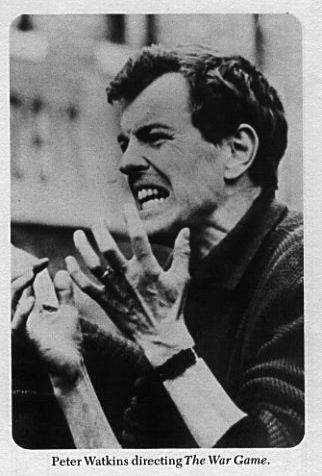 |
 |
| The director as "angry young man" | Still photo from "Culloden" |
FILMS/DOCUMENTARIES AND SOURCE TEXT
- Peter Watkins, Culloden (1964) 1 hr 12
- Paul Murton, Rebellion: Culloden (1996) 50 mins, written by John Prebble
John Prebble, Culloden (Harmondsworth: Penguin, 1961, 1967). But see also John Prebble, The Highland Clearances (Penguin, 1963) and John Prebble, Glencoe: The Story of the Massacre (Penguin, 1966, 1968) the sequel and prequel respectively.
OTHER FILMS OF INTEREST
- Cy Endfield, Zulu (1964) based upon a story by Prebble.
- Ronald Maxwell, Gettysburg (1994) 4.5 hrs - inspired by the historical novel by Michael Shaara, The Killer Angels (New York: Ballantine Books, 1975).
- Ken Burns' documentary for PBS television Civil War and the collection of essays by historians edited by Toplin (Oxford University Press).
KEY READINGS
Joseph A. Gomez, Peter Watkins (Boston: Twayne Publishers, 1979).
S.M.J. Arrowsmith, "Peter Watkins," in British Television Drama, ed. Goerge W. Brandt (Cambridge University Press, 1981), pp. 217-38.
Ina Rae Hark, "On Eyewitnessing History: The Compromised Spectator in Peter Watkin's Culloden," The South Atlantic Quarterly, Summer 1985, vol. 84, no. 3, pp. 294-301.
Jeremy Black, Culloden and the 7'5 (Dover, N.H.: A. Sutton, 1990).
James Michael Hill, "The Distinctiveness of Gaelic Warfare, 1400-1750," European History Quarterly, 1992, vol. 22, no. 3, pp. 323-45.
4. Feature Films and Documentaries as "Mirrors of Contemporary Society" - Leni Riefenstahl and Nazi Propaganda Films
The Woman |
The Aryan Warrior/Athlete |
Das Volk |
Der Fuehrer |
DOCUMENTARY FILM
- Leni Riefenstahl, Triumph of the Will (1935) 2hrs 2 about the 1934 Nuremberg Parteitag
OTHER FILMS OF INTEREST
- Leni Riefenstahl, Olympia (1936) about the 1936 Berlin Olympic Games
- Ray Müller's documentary about Leni Riefenstahl: The Wonderful, Horrible Life of Leni Riefenstahl ()
- Veit Harlan, Kolberg (1945) 1hr 58.
- Frank Capra, Why We Fight (1942)
- Lewis Seiler, Guadalcanal Diary (1943)
- Warner Bros., Bugs and Daffy: Wartime Cartoons (1989)
KEY READINGS ON LENI RIEFENSTAHL
Leni Riefenstahl, The Sieve of Time: The Memoirs of Leni Riefenstahl (1992).
Martin Loiperdinger and David Culbert, "Leni Riefenstahl,
the SA, and the Nazi Party Rally Films, Nuremberg 1933-1934: `Sieg
des Glaubens' and `Triumph des Willens'" Historical Journal
of Film, Radio and Television, 1988, vol. 8, no.1, pp. 3-38.
BSL (M) 791.405H673
Martin Loiperdinger and David Culbert, "Leni Riefenstahl's 'Tag der Freiheit': the 1935 Nazi Party Rally Film," Historical Journal of Film, Radio and Television, 1992,
vol. 12, no.1, pp. 3-40.
David Culbert, "Review Essay: Leni Riefenstahl and the Diaries of Joseph Goebbels,"Historical Journal of Film, Radio and Television, 1993, vol. 13, no.1, pp. 85-93.
Brian Winston, "Film in Context: Triumph of the Will," History Today, January 1997, vol. 47, no. 1, pp. 24-28.
Robert Sklar, "The Devil's Director," Cineaste, 1994, vol. 20, no. 3, pp. 18-21.
Robert Skalr, "Her Talent Was Her Tragedy: An Interview with Ray Müller," Cineaste, 1994, vol. 20, no. 3, pp. 22-23.
J. Caldwell, 'Triumph of the Will and Listen to Britain: propaganda - militant/non-militant', Literature/Film Quarterly 9:1 (1976), pp.52-3.
Cooper C. Graham, "'Olympia' in America, 1938: Leni Riefenstahl, Hollywood, and Kristallnacht," Historical Journal of Film, Radio and Television, 1993, vol. 13, no.4, pp. 433- 50.
Nazi Cinema
David Welch, Propaganda and the German Cinema, 1933-1945 (Oxford: Clarendon Press, 1983).
S. Kracauer, From Caligari to Hitler: A Psychological History
of German Film (Princeton, 1973).
Nazi Propaganda: The Power and the Limitations, ed.
David Welch (London, 1983).
David Stewart Hull, Film in the Third Reich: A Study of the
German Cinema 1933-1945 (Berkeley, 1969).
M.S. Phillips, "The German Film Industry and the New Order,"
in The Shaping of the Nazi State, ed. P.D. Stachura (London,
1978), pp. 257-81.
M.S. Phillips, "The Nazi Control of the German Film Industry," Journal of European Studies, March 1971, vol. 1, pp. 37-68.
Veit Harlan's Kolberg (1945)
Peter Paret, "Kolberg (1945) as a Historical Film and Historical Document," Historical Journal of Film, Radio and Television, 1994, vol. 14, no. 4, pp. 433-48.
David Culbert, "Kolberg: Film, Filmscript and Kolobrzeg Today (Comment by Hans J. Fabian; Photographs by Hans-Joachim Grohmann," Historical Journal of Film, Radio and Television, 1994, vol. 14, no. 4, pp. 449-66.
"Microfiche Supplement: 1. David Culbert and David Welch, Kolberg: An English Translation of the Script" (62 pp.) in Historical Journal of Film, Radio and Television, 1994, vol. 14, no. 4.
5. The Historian as Advisor to Filmmakers - Natalie Zemon Davis
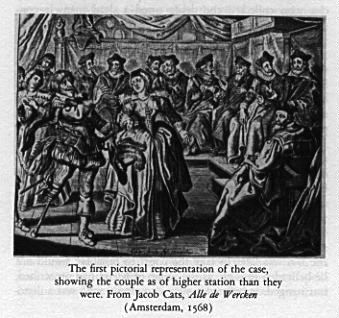 |
| The first pictorial representation of the case |
FILM AND SOURCE TEXT
- Daniel Vigne, The Return of Martin Guerre (1982) 2hr 3 (LD/WS) - Historical advisor Natalie Zemon Davis
- Natalie Zemon Davis, The Return of Martin Guerre (Harvard University Press, 1983).
OTHER FILMS OF INTEREST
- Warren Beatty, Reds (1981) 3hrs 20. Advised by Robert A. Rosenstone who wrote a biography of Reed, Romantic Revolutionary: A Biography of John Reed (1975) and a critical review of the film which resulted "Reds as History," Reviews in American History, 1982, vol. 10, pp. 297-310.
- Peter Weir, Gallipoli (1981) 1hr 50. Advised by Bill Gammage and based upon Bill Gammage's The Broken Years (Penguin, 1974) and C.E.W. Bean's official history. See also Bill Gammage, David Williamson, Peter Weir, The Story of Gallipoli (Penguin, 1987)
KEY READINGS
Robert Brent Toplin, "The Filmmaker as Historian," American Historical Review, December 1988, vol. 93, no. 5, pp. 1210-27.
Daniel Walkowitz, "Visual History: The Craft of the Historian-Filmmaker," Public Historian, 1987, no. 7, pp. 53-64.
NATALIE ZEMON DAVIS
Works By Her
Natalie Zemon Davis, "Inventing Martin Guerre: An Interview," Southern Review, November 1986, vol. 19, no. 3, pp. 231-41.
Natalie Zemon Davis,"'Any Resemblance to Persons Living or Dead': Film and the Challenge of Authenticity," Historical Journal of Film, Radio and Television, 1988, vol. 8, no. 3, pp. 269-283. Also available online at http://www.stanford.edu/dept/HPS/HitoryWired/Davis/DavisAuthenticity.html
Natalie Zemon Davis, "On the Lame", American Historical Review, June 1988, vol. 93, no. 3, pp. 572-603.
Natalie Zemon Davis with Daniel J. Walkowitz for the AHA Ad Hoc Committee on History and Film, "The Rights and Responsibilities of Historians in Regard to Historical Films and Video," Perspectives 30, no. 6, September 1992, pp. 15, 17.
Works about Her
Ed Benson, "Martin Guerre, the Historian and the Filmmakers: An Interview with Natalie Zemon Davis," Film and History, 1983, vol. 13, no. 3, pp. 49-65.
Pat Auferheide, "Interview with Natalie Davis," Radical History Review, 1984, nos. 28-30, pp. 136-39.
Edward Benson, "The Look of the Past: Le retour de Martin Guerre," Radical History Review, 1984, nos. 28-30, pp. 125-35.
Robert Finlay, "The Refashioning of Martin Guerre," American Historical Review, June 1988, vol. 93, no. 3, pp. 553-71.
Carlo Ginzburg, "Proofs and Possibilities: In the Margins of Natalie Zemon Davis' The Return of Martin Guerre", Yearbook of Comparative and General Literature, 1988, no. 37, pp. 113-27.
6. "Hollywood History" - John Ford and the Myth of the West
The Director |
"She Wore a Yellow Ribbon" |
Beer and the Myth of Custer - or Custer's Last Drink? |
|
FILM AND SOURCE TEXT
James Warner Bellah's short stories about "Fort Starke" in Saturday Evening Post.
- "Massacre," Saturday Evening Post, February 22, 1947, vol. 219. pp. 18-9, 140, 142, 144, 146.
- "Command" in The Giant Book of the Western, ed. Jon E. Lewis (Brookvale, Sydney: The Book Company, 1995), pp. 311-25. Along with "Big Hunt" was the basis for the 2nd of Ford's "calvary pictures" She Wore a Yellow Ribbon (1949)
OTHE FILMS OF INTEREST
- Sam Peckinpah, The Wild Bunch (1969) (Director's cut) 2hrs 25 (WS/DVD) - on demythologising the western in the wake of the events of 1968 and the Vietnam War
- Raoul Walsh, They Died with Their Boots On (1941) 2hrs 14 - an heroic depiction of Custer released at the time of the attack on Pearl Harbor
- Arthur Penn, Little Big Man (1970) 2hrs 30. Based upon Thomas Berger's novel Little Big Man (1964) - another 1960s reaction against the myth of the West
The other films in Ford's post-war "cavalry trilogy":
KEY READINGS ON "HOLLYWOOD HISTORY"
Robert Brent Toplin, History by Hollywood: The Use and Abuse of the American Past (Urbana: University of Illinois Press, 1996).
Oliver Stone's USA: Film, History and Controversy , ed. Robert Brent Toplin (University of Kansas Press, 2000).
Hollywood's Indian: The Portrayal of the Native American in Film, ed. Peter C. Rollins and John E. O'Connor (Lexington: University Press of Kentucky, 1998).
- Chap. 5 Ken Nolley, "The Representation of Conquest: John Ford and the Hollywood Indian (1939-1964)," pp. 73-90.
Past Imperfect: History according to the Movies, ed. Mark C. Carnes (New York: Henry Holt, 1995). The following reviews:
- Alvin M. Josephy, Jr. "They Died With Their Boots On," pp. 146-49.
- Dee Brown, "Fort Apache," pp. 150-53.
George MacDonald Fraser, The Hollywood History of the World (Hravill Press, 1996).
American History/American Film: Interpreting the Hollywood Image, ed. John E. O'Connor et al. (New York: Ungar, 1988). 2nd edition.
Hollywood's America: United States History through its Films, eds. S. Mintz and R. Roberts (St. James, New York, 1993.
Resisting Images: Essays on Cinema and History, ed.s R. Sklar and C. Musser (Philadelphia, 1990).
Hollywood as Mirror: Changing Views of "Outsider" and "Enemies" in American MOvies. Contributions to the Study of Popular Culture 38 (Westport, Connecticut: Greenwood Press, 1993).
Hollywood as Historian: American Film in a Cultural Context, ed. P. Rollins (Lexington: University Press of Kentucky, 1983).
K. Brownlow, The War, the West and the Wilderness (London, 1979).
Clayton B. Koppers and Gregory D. Black, Hollywood goes to War: How Politics, Profits, and Propaganda Shaped World War II Movies (London: I.B. Tauris, 1988).
Albert Auster and Leonard Quart, How the War was Remembered:
Hollywood and Vietnam (New York: Praeger, 1988).
Thomas Doherty, Projections of War: Hollywood, American Culture,
and World War Two (New York: Columbia University Press, 1993).
Gilbert Adair, Hollywood's Vietnam: From "The Green Berets"
to "Full Metal Jacket" (London: Heineman, 1989).
Terry Christensen, Reel Politics: American Political Movies
from "Birth of a Nation" to "Platoon" (Oxford: Basil Blackwell, 1987).
Michael Ryan and Douglas Kellner, Camera Politica: The Politics
and Ideology of Contemporary Hollywood Film (Bloomington:
Indiana University Press, 1990).
AMERICAN MYTHS: THE WESTERN, THE FRONTIER, AND CUSTER'S LAST STAND
The BFI Companion to the Western, ed. Edward Buscombe (London: Andre Deutsch, 1988).
Richard Slotkin, Gunfighter Nation: The Myth of the Frontier in Twentieth-Century America (New York: Harper, 1993).
Garry Wills, John Wayne's America: The Politics of Celebrity (New York: Simon & Schuster, 1997).
Brian W. Dippie, Custer's Last Stand: The Anatomy of an American Myth (Lincoln: University of Nebraska Press, 1976, 1994).
The Custer Reader, ed. Paul Andrew Hutton (Lincoln: University of Nebraska Press, 1992). Section on "The Custer Myth," pp. 387-547.
Paul Andrew Hutton, "'Correct in Every Detail': General Custer in Hollywood," in The Custer Reader, pp. 488-524.
Robert M. Utley, Cavalier in Buckskin: George Armstrong Custer and the Western Military Frontier (Norman: University of Oklahoma Press, 1988).
JOHN FORD
Andrew Sarris, "1848-1966: The Poet and Rememberer of Things Past," in The John Ford Movie Mystery (Bloomington: Indiana University Press, 1975), pp. 124-82.
Douglas Pye, "Genre and History: Fort Apache and Liberty Valance," Movie, Winter 1977-78, no. 25, pp. 1-11.
Andrew Sinclair, John Ford (London: George Allen & Unwin, 1979).
Joseph McBride and Michael Wilmington, John Ford (London: Secker and Warburg, 1974).
Dan Ford, Pappy: The Life of John Ford (Englewood Cliffs, New Jersey: Prentice-Hall, 1979).
John Baxter, The Cinema of John Ford (London: Zwemmer, 1971).
SAM PECKINPAH
Sam Peckinpah's The Wild Bunch, ed. Stephen Prince (Cambridge University Press, 1999).
- Stephen Prince, "Introduction: Sam Peckinpah, Savage Poet of American Cinema", pp. 1-36.
- Christopher Sharrett, "Peckinpah the Radical: The Politics of The Wild Bunch", pp. 79-104.
- Wheeler Winston Dixon, "Re-Visioning the Western: Code, Myth, and Genre in Peckinpah's The Wild Bunch", pp. 155-74.
The International Dictionary of Films and Filmmakers. Volume 1: Films, ed. Christopher Lyon (London: Macmillan, 1987).
- David Cook," The Wild Bunch," pp. 521-525.
The International Dictionary of Films and Filmmakers. Volume 2: Directors, ed. Christopher Lyon (London: Macmillan, 1987).
- Andrew Tudor, "Peckinpah, Sam," pp. 410-411.
7. The Filmmaker as Participant and Historian - Pierre Schoendoerffer and the French Indochinese War
 |
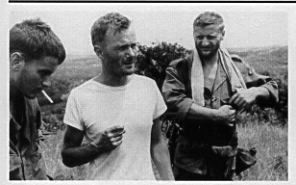 |
| The Camera as a Gun | The director with the lead actors |
FILM AND SOURCE TEXT
- Pierre Schoendoerffer, The 317th Platoon (1965) 1hr 24
- Pierre Schoendoerffer, La 317e section (Paris: La Table Ronde, 1963)
OTHER FILMS OF INTEREST
- A documentary by Schoendoerffer about the American war in Vietnam: The Anderson Platoon (1966)
- Schoendoerffer's recent feature film: Dien Bien Phu (1991)
- Roberto Rossellini, Rome: Open City (1945)
- John Ford, They Were Expendable (1945)
- Oliver Stone, Platoon (1986)
KEY READINGS
Katharine Thornton, 'Selected Memories of the French War of Decolonisation in Indochina', France Abroad: Indochina, New Caledonia, Wallis and Futuna, Mayotte, Robert Aldrich and Isabelle Merle, eds., (Sydney, 1997).
Katharine Thornton, "The Film-maker as Participant and Historian: Pierre Schoendoerffer and La 317 ème Section (1967)", 5 June 1997.
Naomi Greene, "Empire as Myth and Memory," Cinema, Colonialism, Postcolonialism: Perspectives from the French and Francophone World, ed. Dina Sherzer (Austin: University of Texas Press, 1996), pp. 103-19.
Panivong Norindr, "Filmic Memorial and Colonial Blues: Indochina in Contemporary French Cinema," Cinema, Colonialism, Postcolonialism: Perspectives from the French and Francophone World, ed. Dina Sherzer (Austin: University of Texas Press, 1996), pp. 120-46.
J. Daniel, Guerre et cinéma: grandes illusions et petits soldats 1895-1971 (Paris: Armand Colin, 1972).
8. Depicting the Undepictable: The Holocaust on Film
Films
- The World at War - "Genocide" 50 mins
- Claude Lanzmann, Shoah (1985) 4 parts, 9hrs 30
- Steven Spielberg, Schindler's List (1993)
- Elem Klimov, Come and See (1985)
- Andrzej Wajda, Korczak (1990)
The Historian as Documentary Filmmaker: Clause Lanzmann
Claude Lanzmann, "From the Holocaust to "Holocaust"", Dissent, 1981, vol. 28, no. 2, pp. 188-94.
Claude Lanzmann, Shoah: An Oral History of the Holocaust.
The Complete Text of the Filn, trans. A Whitelaw and W. Byron
(New York: Pantheon, 1985).
Morris Dickstein, "Shoah and the Machinery of Death," Partisan Review, 1986, vol. 53, no. 1, pp. 36-42.
Neal Ascherson, "The Shoah Controversy," Soviet
Jewish Affairs, 1986, 16 (1), pp. 53-61.
Thomas Doherty, "Representing the Holocaust: Claude Lanzmann's Shoah," Film and History, 1987, 17 (1), pp.
2-8.
Shoshona Felman, "In an Era of Testimony: Claude Lanmann's Shoah," Yale French Studies,1991, vol. 79, pp. 39-81.
Claude Lanzmann, "Seminar with Claude Lanzmann 11 April 1990,"Yale French Studies,1991, vol. 79, pp. 82-99
.
HOLLYWOOD'S HISTORY OF THE HOLOCAUST: SPIELBERG'S SCHINDLER AS REDEMPTIVE HERO
Spielberg's Holocaust: Critical Perspectives on Schindler's List, ed. Yosefa Loshitzky (Bloomington: Indiana University Press, 1997).
Frank Manchel, "A Reel Witness: Steven Spielberg's Representation of the Holocaust in Schindler's List," Journal of Modern History, 1995, vol. 67, no. 1, pp. 83-100.
Victoria Carchidi, "Schindler's List: At Home with the Holocaust or, Hollywood Atrocities," Australasian Journal of American Studies, July 1996, vol. 15, no. 1, pp. 65-76.
Annette Insdorf, Indelible Shadows: Film and the Holocaust (2nd edition, Cambridge University Press, 1989).
Shoshana Felman, "Film as Witness: Claude Lanzmann's Shoah" in Geoffrey H. Hartman (ed.), Holocaust Remembrance: The Shapes of Memory, (Cambridge MA: Blackwell, 1994), pp. 90-103.
Lawrence Langer, "The Americanization of the Holocaust on Stage and Screen", in Lawrence L. Langer, Admitting the Holocaust. Collected Essays, (New York: OUP 1995), pp. 157-178.
GORBACHEV'S POLICY OF PERESTROIKA AT THE MOVIES: KILMOV
Denise J. Youngblood, "Post-Stalinist Cinema and the Myth of World War II: Tarkovskii's Ivan's Chiuldhood (1962) and Klimov's Come and See (1985)," Historical Journal of Film, Radio and Television, 1994, vol. 14, no. 4, pp. 413-20.
HOLOCAUST HERO PART II; WAJDA'S KORCZAK
Betty Jean Lifton, The King of Children (London: Pan
Books, 1989)..
Janusz Korczak, Ghetto Diary, trans. Jerzy Bachrach and
Barabar Krzywicka (New York: Holocaust Library, 1978)..
Janusz Korczak, The Warsaw Ghetto Memoirs of Janusz Korczak,
trans. E.P. Kulawiec (Washington, D.C.: The University Press of
America, 1978)..
The Warsaw Diary of Adam Czerniakow, eds. Raul Hilberg
et al. (New York, 1979).
"Janusz Korczak Symposium," The Polish Review, 1979, vol. 24, no. 1, pp. 22-45.
9. Documentaries and History
INTRODUCTION
To put the historical feature films we will be watching into some kind of perspective I thought we should view some "historical documentaries". Depending upon the interests of the seminar participants, the following are available:
- The World at War (1973) - commemorating the 30th anniversay of WW2.
- Frontier (1997)
- Ken Burns, The Civil War (1990)
- Claude Lanzmann, Shoah (1985)
- Walter Cronkite, The Vietnam War ()
- Lawrence Pitkethly, American Cinema (1994).
SELECTED READING
On Claude Lanzmann see the Reading on The Holocaust.
The companion book to The World at War (1973) TV series by Foster (?).
Henry Reynolds, Frontier ().
CD-ROM version of Frontier for schools.
Ken Burns's The Civil War: Historians Respond, ed. Robert Brent Toplin (Oxford University Press, 1997).
Companion book to TV series: Geoffrey C. Ward (with Ric and Ken Burns), The Civil War: An Illustrated History (New York: , 1990).
Companion book to TV series: John Belton, American Cinema/American Culture (New York: McGraw Hill, 1994).
ON DOCUMENTARIES AS HISTORY
Paula Rabinowitz, "Wreckage upon Wreckage: Hisotry, Documentary and the Ruins of Memory," History and Theory, 1992, 32 (2), pp. 119-37.
Barabar Abrash and Daniel T. Walkowitz, "Sub/versions of History: A Meditation on Film and Historical Narrative," History Workshop Journal, 1994, 38, pp. 203-14.
The Exam - A Selection of Past Exam Questions
[Note: I asked the students to come up with their own exam questions which we discussed in the final seminar. Many of those questions made up the final exam.]
Duration: Three (3) hours (plus 10 minutes reading time)
GENERAL INSTRUCTIONS
You have three (3) hours in which to answer three (3) questions:
- the compulsory question from Section I
- one (1) question from Section II on "The Relationship Between Film and History"
- one (1) question from Section III on "Specific Films, Directors, and Genres"
For the compluslory question and the questions in Section II your answers should refer to at least two or three (2-3) films. You may attempt any question with the proviso that there be no substantial doubling up or duplication of your answers.
I. THE COMPULSORY QUESTION
(Everybody must answer this question)
Evaluate the following claim made by the film critic and historian Dyson, in the light of at least two or three (2-3) films you have studied in this subject:
Although art may occassionally dispense with "fact" (since, at its best, art reveals cultural biases that shape radically opposed interpretations of events), it has an obligation to tell, if not the truth, then its truth.
OR
Marshall Flaum in the "Foreword" to Nuclear War Films, ed. Jack G. Shaheen (Carbondale: Southern Illinois University Press, 1979) states:
Films are mirrors of our lives and times. During the course of the century our changing society, our evolving attitudes and concerns - our history, in fact - have been reflected in our films. Perhaps less explicitly in features than in documentaries, but no less emphatically. Even the distortions and lies we often find in that celluloid mirror reveal some inescapable truths not only about those who created the falsity, but about those who demanded it and avidly paid for it at the box office. As such, the motion picture is fit study for the historian and the sociologist as much as it is for the film student.
What do you think "that celluloid mirror" has to teach historians?
OR,
How valid is Robert Rosenstone's remark that the process of transferring words on the page of a history book (or ideas about the past in the mind of the filmmaker) into flickering images on a screen changes "history" into something else,? Discuss with reference to one or more films and/or filmmakers we have examined during the semester:
No matter how serious or honest the filmmakers, and no matter how deeply committed they are to rendering the subject faithfully, the history that finally appears on the screen can never fully satisfy the historian as historian (although it may satisfy the historian as filmgoer). Inevitably, something happens on the way from the page to the screen that changes the meaning of the past as it is understood by those of us who work in words." (Robert A. Rosenstone, "History in Images/History in Words: Reflections on the Possibility of Really Putting History into Film," American Historical Review, December 1988, vol. 93, no. 5, pp. 1173-85. Quote on p. 1173.)
II. QUESTIONS ON THE RELATIONSHIP BETWEEN FILM AND HISTORY
(Answer only ONE (1) question from this section)
1. Marshall Flaum in the "Foreword" to Nuclear War Films, ed. Jack G. Shaheen (Carbondale: Southern Illinois University Press, 1979) states:
Films are mirrors of our lives and times. During the course of the century our changing society, our evolving attitudes and concerns - our history, in fact - have been reflected in our films. Perhaps less explicitly in features than in documentaries, but no less emphatically. Even the distortions and lies we often find in that celluloid mirror reveal some inescapable truths not only about those who created the falsity, but about those who demanded it and avidly paid for it at the box office. As such, the motion picture is fit study for the historian and the sociologist as much as it is for the film student.
What do you think "that celluloid mirror" has to teach historians?
2. In the late 20th century, has film on the "big screen" replaced written history and oral tradition as the means of satisfying what Rosenstone has described as "the need for that larger history, that web of connections to the past that holds a culture together, that tells us not only where we have been but also suggests where we are going." Discuss with reference to 2-3 films you have studied in this subject.
3. Select 2-3 feature films or documentaries you have studied in the subject and compare and contrast the kinds of history "told" by traditional written texts and by visual media. In your answer you might reflect upon what type of history (if any) is better suited to each medium, and what, in your view, are the strengths and weaknesses of each way of telling historical stories?
4. Discuss, with reference to at least two films, James Snead's claim that:
one may formulate the history of black film stereotypes as the history of the denial of history in an artificially constructed mythology about an unchanging black "character" or "nature".
5. John Sayles observes that:
I feel that history, especially the stories we like to believe or know about ourselves, is part of the ammunition we take with us into the everyday battle of how we define ourselves and how we act toward other people. ("A Conversation between Eric Foner and John Sayles," Past Imperfect: History according to the Movies, ed. Mark C. Carnes (1995), p. 11).
To what extent is film ammunition in the battle for self-definition for individuals, classes, races, and nations?
6. Discuss the claim that "Too often historical films deal with national myth rather than with national history per se".
7. What part has war played in the history of cinema? What connection is there (if any) between sighting along the barrel of a gun and focussing a camera? (Virilio)
8. Discuss the differences between historical "accuracy" and what Natalie Zemon Davis calls historical "authenticity" in film.
9. Using Natalie Zemon Davis's guidelines drawn up for the American Historical Association on the duties and responsibilities of historians who act as historical advisors to filmmakers, what advice would you give a filmmaker who was planning to make an historical feature fillm? What pitfalls do you think need to be avoided? In what areas do special efforts need to be made in order to ensure historical accuracy or authenticity?
10. In George MacDonald Fraser's The Hollywood History of the World (1996) he claims that
(there is) a popular belief that where history is concerned, Hollywood always gets it wrong - and sometimes it does. What is overlooked is the astonishing amount of history it has got right and the immense, unacknowledged debt that we owe to the commercial cinema as an illuminator of the story of mankind.
Evaluate the accuracy of "Hollywood history" with respect to the films of Walt Disney Pictures, or Oliver Stone, or Stephen Spielberg.
11. What in your opinion is the relationship between the depiction of gender stereotypes (male or female) in film in the post-war period and the historical changes which were taking place in the family, the workplace, and in society at large at the same time? In your answer you should refer to at least 2 films you have studied this semester.
12. Compare and contrast the kinds of history "told" by traditional written texts (monographs, articles) and by visual media (historical feature films, documentaries). What type of history (if any) is better suited to each medium? What are the strengths and weaknesses of each way of telling historical stories.
13. How do or should filmmakers deal with the problem of depicting violence in historical films? How do they or should they balance the need for "historical accuracy" against the need not to offend the sensibilities of the audience or the broader community?
14. Discuss the tension which exists for historical filmmakers between the necessity to satisfy "the bottom line" and the desire they might have to represent history as accurately as possible.
15. Discuss in detail an example of a feature film which gets its history (basically) right and an example of a feature film which gets its history (horribly) wrong. What, in your opinion, makes the difference between the two films?
16. Select a representative film from one of the following genres and discuss how history is (mis-)represented in it:
- western
- war film
- costume or historical drama
- spy film/thriller
- romance
- sci-fi
- children's animated feature
17. Discuss the contribution one or more historians have made as advisors to filmmakers. Does their participation provide the film with any historical validy and, if so, how?
18. What are the physical and moral limitations of historical features films? What apsects of history cannot be shown on the screen? What are the implications of these limitations on the usefulness of film as a way of depicting the past on the screen?
III. QUESTIONS ON SPECIFIC FILMS, DIRECTORS, AND GENRES
(Answer only ONE (1) question from this section)
1. What is the "Rashomon Effect" and what lesson or lessons can Kurosawa teach historians?
2. With respect to at least one documentary you have seen in this subject discuss the ways documentary filmmakers attempt to "restage the past". What are the strengths and weaknesses of documentaries as a means of presenting history to an audience?
3. Discuss the claim that "Leni Riefenstahl's documentary Triumph of the Will (1935) is the best propaganda film ever made."
4. What is "the myth of the West" and what roles did John Ford and/or John Wayne play in creating this myth?
5. Discuss the claim that
Schoendoerffer is a captive of his own past - a POW of his memory of his own military experience, if you will. Having lived through the Indochinese War he is destined to relive it again and again in his films.
6. Assess the strengths and weaknesses of the film The Return of Martin Guerre vis-à-vis the book of the same name by Natalie Zemon Davis as works of history.
7. Select a representative film from one of the following genres and discuss how history is (mis-)represented in it:
- western
- war film
- costume or historical drama
- spy film/thriller
- romance
- sci-fi
- black cinema
8. How does Sam Peckinpah attempt to demythologise the traditional Hollywood "western" in The Wild Bunch (1969)? In your view, how successful is he?
9. With respect to Akira Kurosawa's Rashomon (1951), what is the "Rashomon Effect" and what lesson or lessons can Kurosawa teach historians?
10. Discuss the techniques Peter Watkins uses to "restage the past" in his film Culloden (1969). What are the strengths and weaknesses of this type of documentary filmmaking as a means of presenting history to an audience?
11. Discuss the claim that "Leni Riefenstahl's documentary Triumph of the Will (1935) is the best propaganda film ever made." (You might want to compare and contrast it with Olympia (1936) where this is appropriate).
12. Assess the strengths and weaknesses of the film The Return of Martin Guerre (1982) vis-à-vis the book of the same name by Natalie Zemon Davis as works of history.
13. Using John Ford's film Fort Apache (1948) as a starting point, what is "the myth of the West" and what roles did John Ford and/or John Wayne play in creating this myth?
14. Discuss the claim that
Schoendoerffer is a captive of his own past - a POW of his memory of his own military experience, if you will. Having lived through the Indochinese War he is destined to relive it again and again in his films.
How can a filmmaker who was also a participant in the events s/he depicts give an reliable account of what transpired?
15. Evaluate the strengths and weaknesses of Andrzej Wajda's film Korczak (1990) in "depicting the undepictable" on film. (You might want to compare and contrast it with Spielberg's Schindler's List (1993)).
16. Discuss Claude Lanzmann's documentary filmmaking technique in Shoah (1985). What are its strengths and weaknessess in analysing historical events? What kind of history has he created?
17. Joan the military leader; Joan the naive and gullible young peasant girl; Joan the messenger of god - what image of Joan of Arc does Luc Besson give us in The Messenger: The Story of Joan of Arc (1999) and is it historically accurate?
18. Discuss how Margarethe von Trotta in her film Rosa Luxemberg (1986) grapples with the twin problems of making a "bio-pic" and a film about "ideas". How successfull is she in solving these problems?
19. Is Leni Riefenstahl's Olympia (1936) a path-breaking and innovative sports documentary or just another Nazi propaganda film?
20. To what extent is Walt Disney Pictures' Hercules (1997) a commendable effort in bringing ancient history to the attention of the film-going public or another "historical travesty" from this Hollywood studio? Discuss.
21. Devise your own question on a specific film or director of your choice.
